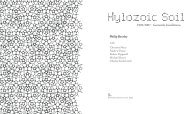The Inner Studio - Riverside Architectural Press
The Inner Studio - Riverside Architectural Press
The Inner Studio - Riverside Architectural Press
You also want an ePaper? Increase the reach of your titles
YUMPU automatically turns print PDFs into web optimized ePapers that Google loves.
PART SIX | THE PROLIFERATION OF DESIGN<br />
person to effect healing. This means that the conscious and unconscious<br />
aspects of the world need to be brought into the light of<br />
design. This is not a naive idea–it is a practical idea based on<br />
observing our current world. It is about the necessity for the heart<br />
and mind to wrestle with the uncontrollable energy of creation. We<br />
need to be willing to wrestle with all the energies that make our<br />
built world. This, of course, takes time to learn, time to practice,<br />
and time to implement. This is not a revolution that can happen in<br />
the space of an advertisement. We need to be willing to undertake<br />
long-term and difficult assignments. Our new understanding<br />
involves not isolating or celebrating the unconscious, but taking<br />
responsibility for it, and wrestling it down to a more consciously<br />
transformed earth.<br />
Breaking Through<br />
Creativity is a type of learning where the teacher and pupil are located in<br />
the same individual.<br />
–ARTHUR KOESTLER<br />
At the heart of design has always been the desire to make the<br />
world better. I became convinced of this through two very different<br />
experiences. First, the unshakable altruism, energy, and joy always<br />
present in the work of students when they are given the opportunity<br />
to express themselves through the act of design. Students have<br />
powerful instincts about what is missing from the world. <strong>The</strong>y<br />
need a seat at the table when important decisions are being<br />
debated. Second, the seemingly infinite variety of spaces, artifacts,<br />
and places that cultures generate when they express themselves<br />
through design. <strong>The</strong> places of worship in Assisi are different from<br />
those in Kyoto, as are the teacups, houses, and streetscapes, yet<br />
there is a palpable sense of fit between place and the needs of<br />
people. This is based on a timeless sense that design is capable<br />
of fulfilling a deep and intimate call that is persistent in humanity.<br />
For centuries designers have been trying to make the built world<br />
a place where we belong, thrive, and live more happily. Living<br />
175





